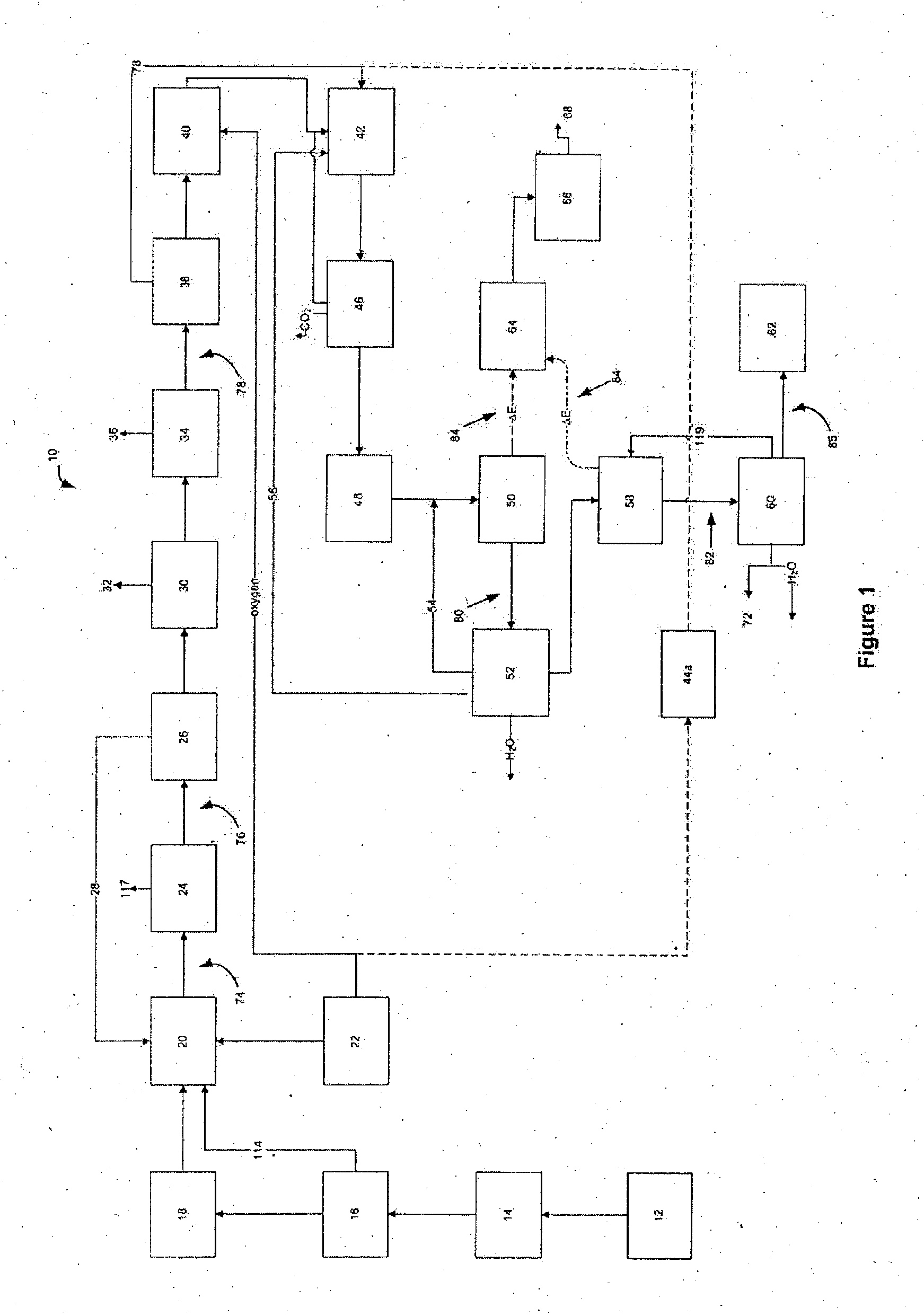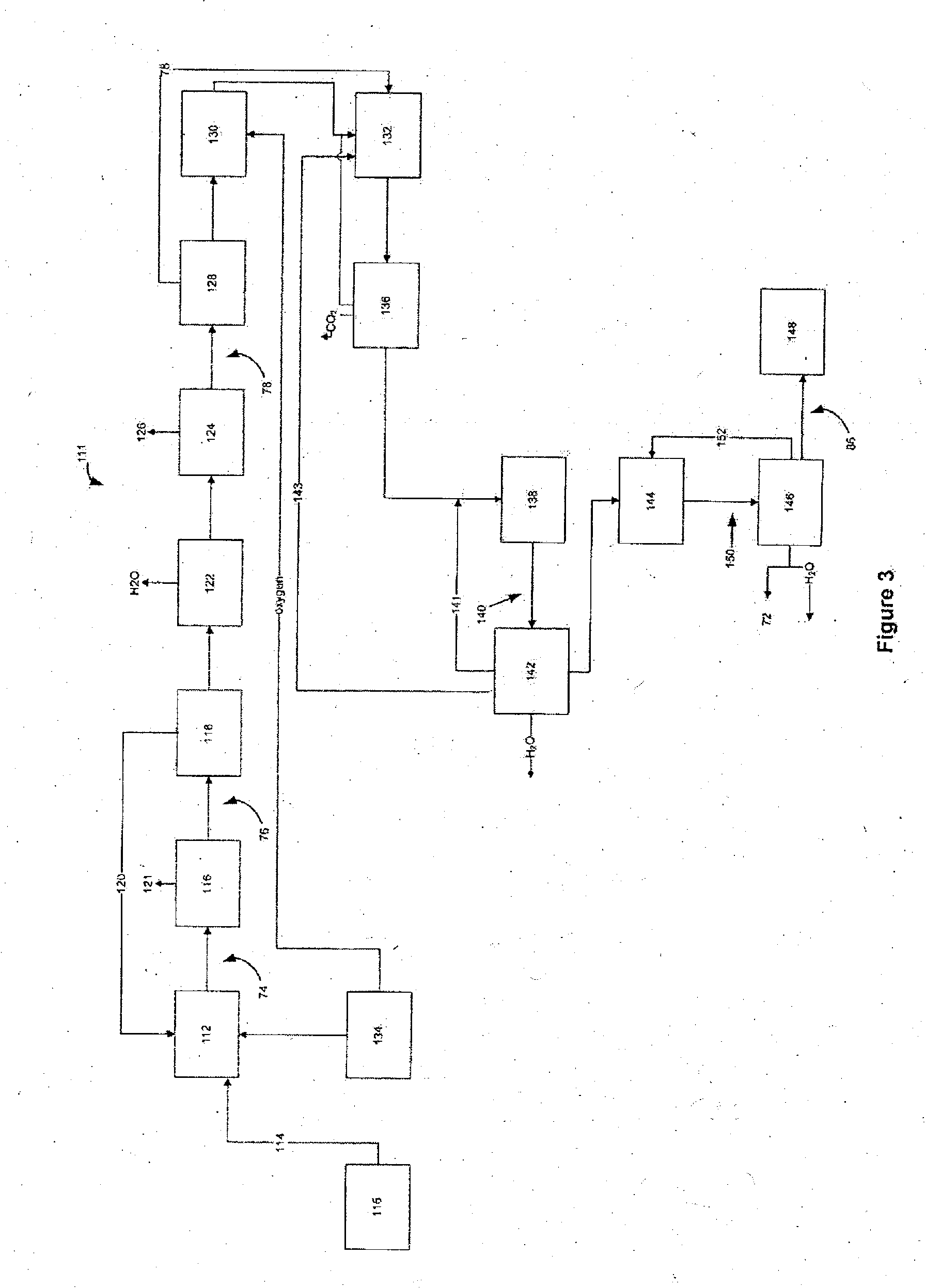Production of hydrocarbon liquids
- Summary
- Abstract
- Description
- Claims
- Application Information
AI Technical Summary
Benefits of technology
Problems solved by technology
Method used
Image
Examples
example 1
[0053]The primary elements of the process for producing liquid and gaseous hydrocarbons, plus water, of the present invention is shown generally at 10 in the block diagram of FIG. 1. In this diagram, solid organic material such as wood is utilized as organic feedstock 12. In the following description, variations on the process are included.
[0054]Organic feedstock 12 is prepared to enter the heating device also herein referred to as the gasifier 20. The organize feedstock 12 can be comprised of any or a combination of vegetative material, components of household garbage, man-made organic compounds such as plastic or rubber or a described above. In a preferred embodiment, wood chips are prepared as described with reference to FIG. 1, by reducing in particle size 14 and drying 16 to suit uniform feeding and heating. Following preparation, the wood chips 12 are then fed into the heating device 20. The heating device 20, for example, may be, but not limited to, a fluidized bed gasifier, ...
example 2
[0071]In an alternative embodiment disclosed in the present example, generally shown in FIG. 2 at 83, a gaseous organic feedstock 87 is utilized. For the purposes of the present example, the gas may be a single compound or a mixture of carbon-based organic gases. It should be understood that non-carbon-based gases and compounds may also be present in the gaseous organic feedstock 87 of the present example. For example, the gases referred to in the present example may be those resulting from the anaerobic digestion of manures or municipal sewage sludge, or landfill gas, which are likely to be or contain methane and carbon dioxide among other present compounds. By way of example of a single compound is propane, which may be the by-product of another process, can be utilized in an embodiment of the present example. The aforementioned gases are by way of examples; one skilled in the art will appreciate that many different possibilities exist for gaseous organic feedstock 87, which may a...
example 3
[0082]In an alternative embodiment disclosed in the present example, generally shown in FIG. 3 at 111, liquid organic feedstock 115 is processed. For exemplary purposes, the liquid organic feedstock 115 may be bio-oil from the pyrolysis of cellulosic material. Alternatively, or in combination with the preceding, the liquid organic feedstock 115 may be black or green liquour resulting from the processing of wood for the preparation of pulp. As will be readily appreciated, the most appropriate liquid organic feedstocks 115 will be generally known as liquids which are “carbon-rich”.
[0083]With reference to FIG. 3, the organic feedstock liquids 115 are fed into a heating device or gasifier 112. The heating device or gasifier 112 partially oxidizes liquid organic feedstock 115 to produce a synthesis gas 74 comprised primarily of carbon monoxide and hydrogen, but also may include carbon dioxide, hydrocarbons such as alkanes, alkenes or alkynes, suspended particulate matter, tars, or light ...
PUM
| Property | Measurement | Unit |
|---|---|---|
| Temperature | aaaaa | aaaaa |
| Temperature | aaaaa | aaaaa |
| Temperature | aaaaa | aaaaa |
Abstract
Description
Claims
Application Information
 Login to View More
Login to View More - R&D
- Intellectual Property
- Life Sciences
- Materials
- Tech Scout
- Unparalleled Data Quality
- Higher Quality Content
- 60% Fewer Hallucinations
Browse by: Latest US Patents, China's latest patents, Technical Efficacy Thesaurus, Application Domain, Technology Topic, Popular Technical Reports.
© 2025 PatSnap. All rights reserved.Legal|Privacy policy|Modern Slavery Act Transparency Statement|Sitemap|About US| Contact US: help@patsnap.com



